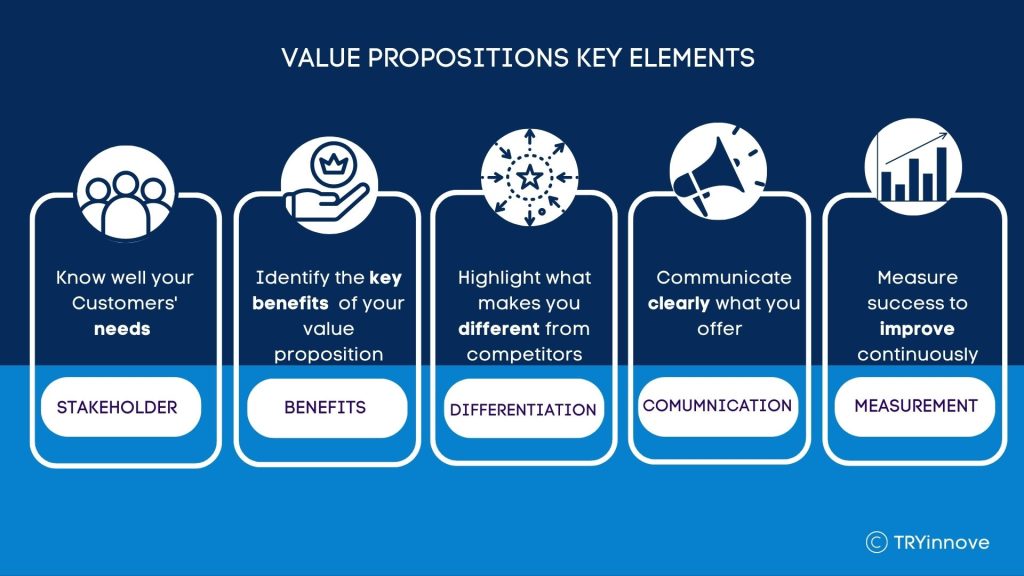The pharmaceutical industry is highly competitive. Companies are constantly looking for new ways to differentiate themselves and meet customer needs.
But do pharmaceutical companies really need a value proposition to achieve these goals?
The answer is a resounding YES. An effective value proposition can help pharmaceutical companies differentiate themselves from the competition and increase adoption of their products and services. By focusing on the key benefits that are important to their customers, companies can improve their satisfaction and build strong, lasting relationships with them.
In this blog we will analyze why it is important to design a value proposition in pharmaceutical companies and explore some ideas to start creating it and thus strengthen the relationship with the main health stakeholders while improving differentiation in a highly competitive environment such as the health sector.
Introduction to the Value Proposition in the health sector

Let’s start by defining…
What is a value proposition?
A value proposition is the promise that a company makes to its customers to offer a product or service that meets their needs and desires in a unique and valuable way.
In the health sector, an effective value proposition must provide solutions that improve the quality of life of patients, as well as create value for the health professionals who care for them, without forgetting the administration in charge of the management of the health system itself.
How to design a value proposition in pharma?

Key elements to design a value proposition for pharmaceutical companies are:
1. Knowledge of the stakeholder
It requires extensive market research to understand the trends and challenges of the health sector, as well as to identify the specific needs and desires of patients and the health professionals and management agents involved.
2. Identification of key benefits
The benefits must be significant, relevant, and unique to differentiate themselves from the competition, they can include the efficacy of the treatment, the reduction of side effects, ease of use, the improvement of quality of life, the reduction of costs for patients and health systems, etc.
3. Differentiation
The evaluation of the competition should include the analysis of your value propositions, your marketing strategy and your positioning in the market. Only in this way is it possible to ensure that our value proposition is unique and differentiated.
4. Clear communication
An effective value proposition must be communicated clearly and concisely to all stakeholders involved to ensure they understand the benefits of the products or services and can communicate them effectively to their patients.
5. Measuring success
It is critical to measure the success of the value proposition to determine whether it meets objectives and provides the desired value to customers and to identify areas for improvement to ensure it remains relevant and effective in an ever-changing market.

Let’s reassess whether it is really necessary to build a value proposition in the pharmaceutical sector…..
Some data and evidence that support the need for a value proposition in the health sector
- Competition in the pharmaceutical market is increasingly complex.
According to a 2019 study by consulting firm Deloitte, 55% of pharmaceutical companies surveyed believed that developing a strong value proposition was essential to achieving success in the saturated market.
Deloitte. (2019). Global Life Sciences Sector Outlook
- Patient expectations are changing.
62% of patients expect pharmaceutical companies to offer comprehensive healthcare solutions. An effective value proposition can help pharmaceutical companies meet changing patient expectations and thereby increase their satisfaction and loyalty.
Accenture. (2019). Patient engagement: A key to success in pharma.
- Personalization is becoming increasingly important
Pharmaceutical companies must develop a patient-centric and personalization-centric value proposition strategy to adapt to changes in patient expectations and the regulatory environment. 68% of patients expect pharmaceutical companies to offer personalized healthcare solutions.
The Deloitte Center for Health Solutions. The future awakens: Life sciences and health care predictions 2021.
- Need to change business models
Pharmaceutical companies must develop a value proposition that focuses on digital transformation, personalization, and innovation in business models, to adapt to the rapidly changing healthcare environment. 82% of pharmaceutical executives expect digital transformation to fundamentally change the industry.
PwC. (2021). Global Life Sciences Sector Outlook.
- New technologies are transforming the sector
Pharmaceutical companies must develop a value proposition that addresses the evolving healthcare environment, focusing on personalization, innovation, and digital transformation. 71% of patients expect pharmaceutical companies to use digital technologies to improve healthcare.
Accenture. (2021). Decoding The Future of Life Sciences.
- Optimization of resources and increase of efficiency
The application of artificial intelligence can help improve the efficiency of healthcare and reduce costs through the automation of repetitive tasks, the optimization of clinical processes, improvement of supply chain management among others. According to a McKinsey report, automating administrative tasks could free up to 30% of healthcare professionals’ time so they can devote to direct patient care.
McKinsey & Company. (2018). The Future of Personalized Healthcare.
- 7. Growing demand for omni-channel experience
Creating value for all health stakeholders
An effective value proposition can be the key to meeting the needs and desires of customers in the pharmaceutical industry. To create value for all health stakeholders, it is important to understand the needs and desires of each group and design strategies and solutions with tangible benefits for each.

Healthcare professionals
For healthcare professionals, the efficacy and safety of medicines and treatments are important, but they also value ease of use and continuing education and training. However, an effective and sustained value proposition over time must go beyond the promotion of medicines and the offer of training programs, although these remain a very important basis to help health professionals improve their knowledge and skills and consequently establish a relationship of trust and credibility with them.
By offering comprehensive healthcare solutions, patient support services and focusing on the research and implementation of technologies and tools that facilitate their daily work and allow them to offer more personalized care. These solutions can include digital health tracking applications, patient communication systems, and health data management systems. Thus, pharmaceutical companies can help healthcare professionals improve efficiency in the delivery of healthcare services and improve the patient experience. Close collaboration between companies and health professionals is increasingly necessary to co-create and introduce solutions focused on improving the quality of life of patients and providing them with greater autonomy in the management of their disease.
Patients
Patients are looking for solutions that help them improve their health and well-being. Offer solutions that are more convenient and offer a unique and positive patient experience.
Some examples of strategies to create value for patients:
- • Improving accessibility to treatments is critical for patients, especially those suffering from chronic and debilitating diseases.
- • Personalization of treatments thanks to advances in genomic research and the use of multi-omics technologies that are helping to introduce increasingly sophisticated and individualized treatments.
- The lack of information and education for patients today is one of the most important barriers for them. Implementing educational projects focused on patient needs can improve therapeutic outcomes while improving the patient experience and achieving a competitive advantage.
Administration
For the administration, reducing costs and improving efficiency in the delivery of health services are important, as well as innovation and advanced technology. Other aspects to consider creating value for the administration would be:
- • Encourage innovation and the development of new products and technologies through collaborative innovation programs that involve researchers, entrepreneurs, and industry experts in the search for solutions to unmet health needs.
- Compliance with current regulations is one of the most important concerns of project development management. Implementation of monitoring systems for the quality of products and services, the creation of additional security measures, assisting in the implementation of patient monitoring and registration systems could be some of the services to be developed jointly with the administration.
- Showing strong corporate social responsibility is becoming increasingly relevant for management. Developing projects that promote it, such as the implementation of volunteer programs, the creation of sustainability initiatives, and the commitment to diversity and inclusion would be some of the examples most valued by the administration.

In short….
To create value for health stakeholders, companies must focus on strategies and projects that allow them to meet the needs and expectations of each group.
In the boom of the multiple applications of artificial intelligence we cannot ignore its benefits in terms of creating value for each stakeholder. AI can be used for the discovery of new drugs, the personalization of treatments, the identification of patients at risk of diseases and improvement in more accurate diagnosis, as well as for improving the efficiency of research and development processes of new treatments and solutions. Pharmaceutical companies must incorporate these new advances throughout the process of creating value for their customers. Only those that will know how to take advantage of their value will be able to strengthen their position in the market that is increasingly competitive and where it is increasingly difficult to differentiate themselves.




